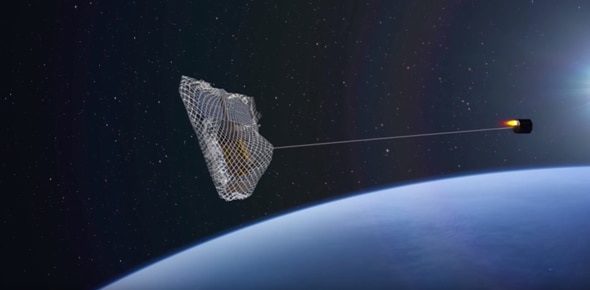Create a free profile to get unlimited access to exclusive videos, sweepstakes, and more!
What Do You Do With a Problem Like Space Debris?

Space junk is becoming a real problem.
It’s a serious issue. There’s a common misconception that things in space are just kindof floating out there, moving slowly—and given videos of spacewalks and what we see in movies, that’s understandable.
But it’s wrong. There are thousands of satellites orbiting the Earth, moving at incredibly high speeds. Note the plural, “speeds”; not everything is traveling at the same speed or in the same direction. Two objects moving at 25,000 kph in different orbits can have a relative speed of several kilometers per second. At that velocity, a fleck of paint can have a catastrophic impact.
If two entire satellites collide, the problem is hugely worse; they create a shower of debris that expands and can hit more satellites, creating a cascade of debris. This was the basis of the movie “Gravity”, you may recall. That flick grossly exaggerated the problem for dramatic effect, but the overall idea was based on reality. In fact, in 2009 just such a situation occurred when a defunct Russian communication satellite slammed into Motorola Iridium satellite; the energy of the impact utterly destroyed the two and created two clouds of debris moving in different directions.
Space debris is a very real threat. What can be done about it? NASA and the Department of Defense have been cooperating on this for a long time, but the European Space Agency is looking into taking the next step: a satellite called e.Deorbit. It’s in the proposal stage, awaiting ESA approval to actually get started. But if approved, the hope is that it will be tag, snag, and bag large pieces of orbital debris, then perform a de-orbit burn to drop them both into Earth’s atmosphere where they will burn up.
It’s ambitious, I’ll say that, but the basic idea makes sense. It will use advanced imaging techniques to identify debris, approach it carefully, securely capture the debris (either by deploying a net or harpoon that will hook it, or a grapple that will grab it), then drop down to a fiery disposal during re-entry.
ESA put together a nice video explaining the concept:
I think this is a good step in reducing the problem. Bear in mind it’s one step; the problem of small (centimeter-sized) debris is still a huge one. There are quite a few ideas floating around (so to speak) on how to mitigate that, including using lasers to heat up the debris and change their orbit, dropping them down into the atmosphere to burn up, and a Japanese idea to use a space tether to create an electromagnetic field that alters the orbits of debris. It would also help to create satellites that shed less debris in the first place, and ESA is looking into that as well.
I’m all for that. If we go about business as usual, the space around Earth will get clogged with material, making routine access to space more dangerous. Something must be done, and it’s nice to see government agencies taking it seriously.














